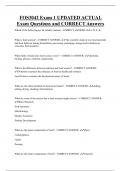FOS3042 Exam 1 UPDATED ACTUAL
Exam Questions and CORRECT Answers
Which of the following are fat soluble vitamins - CORRECT ANSWER- ✔✔A, D, E, K
What is food science? - CORRECT ANSWER- ✔✔The scientific study of raw food materials
and their behavior during formulation, processing, packaging, storage and evaluation as
consumer food products.
What fields of study does food science cover? - CORRECT ANSWER- ✔✔chemistry,
biology, physics, nutrition, engineering
What is the difference between nutrition and food science? - CORRECT ANSWER-
✔✔Nutrition examines the influence of food on health and wellness
Food Science examines the biochemical nature of foods
What are the oldest methods of food preservation? - CORRECT ANSWER- ✔✔milling,
salting, drying, smoking, fermentations
What are some of the careers that a food scientist might choose? - CORRECT ANSWER-
✔✔Basic Research
food chemistry
Microbiology
Quality Assurance
Product Development
What are the major components of food? - CORRECT ANSWER- ✔✔Water
Carbohydrates
Lipids
Proteins
What are the minor components of food? - CORRECT ANSWER- ✔✔Vitamins
, Minerals
Phytochemicals
What are some of the beneficial aspects of knowing the composition of food? - CORRECT
ANSWER- ✔✔Evaluating nutritional value
Plan and evaluate food consumption
Nutritional counseling
Nutritional content of a diet
What is a proximate analysis? - CORRECT ANSWER- ✔✔Standardized methods for
determining nutrient content - Moisture, protein, carbs, fat , fiber mineral (ash)
How does food supply energy to the human body? - CORRECT ANSWER- ✔✔calories
What are the food categories used in the food industry? - CORRECT ANSWER-
✔✔Beverages
Cereals, grains, breads and baked products
Fruits and Vegetables
Legumes and nuts
Milk and dairy products
Meats, poultry, seafood, eggs
Chocolate and confectionary (sugars and sweets)
Fats and Oils
What are the functions of water in food? - CORRECT ANSWER- ✔✔1. heat transfer
(boiling, simmering, steaming, stewing, braising), 2. universal solvent (solution, colloidal
dispersion, suspension, emulsions), 3. chemical reactions, ionization, changes in pH, salt
formation, hydrolysis, 4. food preservation, CO2 release)
What are the categories of carbohydrates? - CORRECT ANSWER- ✔✔1. monosaccharides
(smallest form, non hydrolysable), 2. oligo (di-, tri-, and dextrin) made of several
monosaccharides, hydrolysable. disaccharides (most common, sucrose aka table sugar)
(glucose + fructose) 3. polysaccharides, very large polymers of monosaccharides




